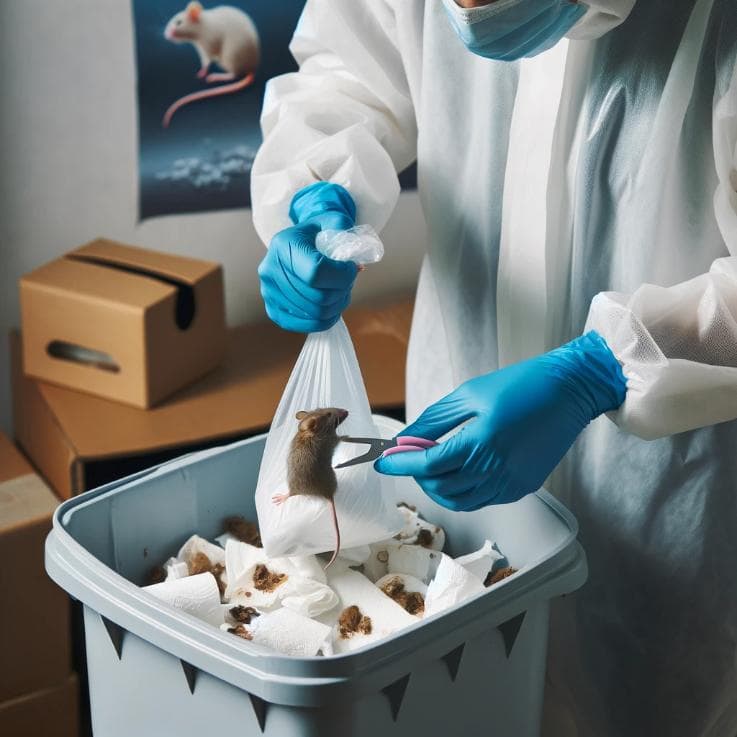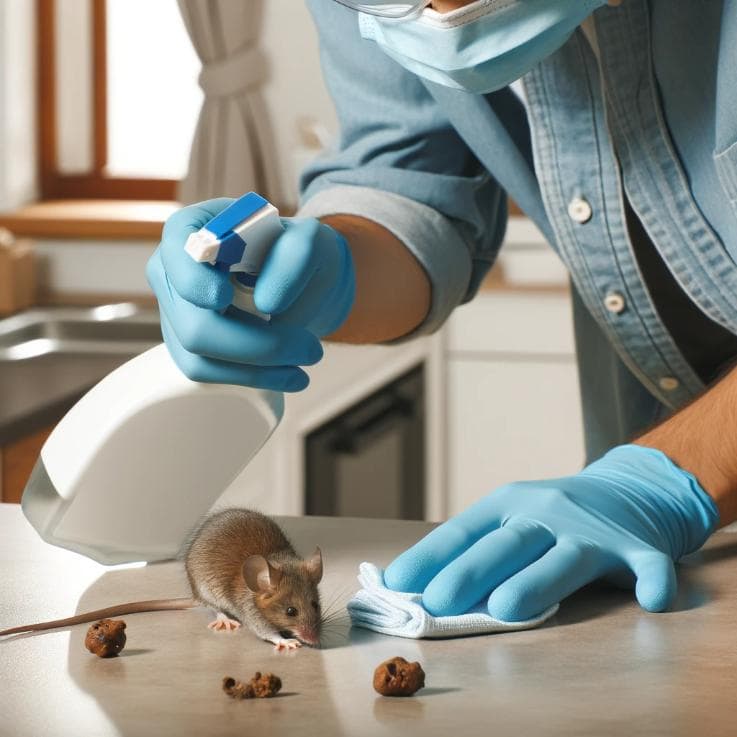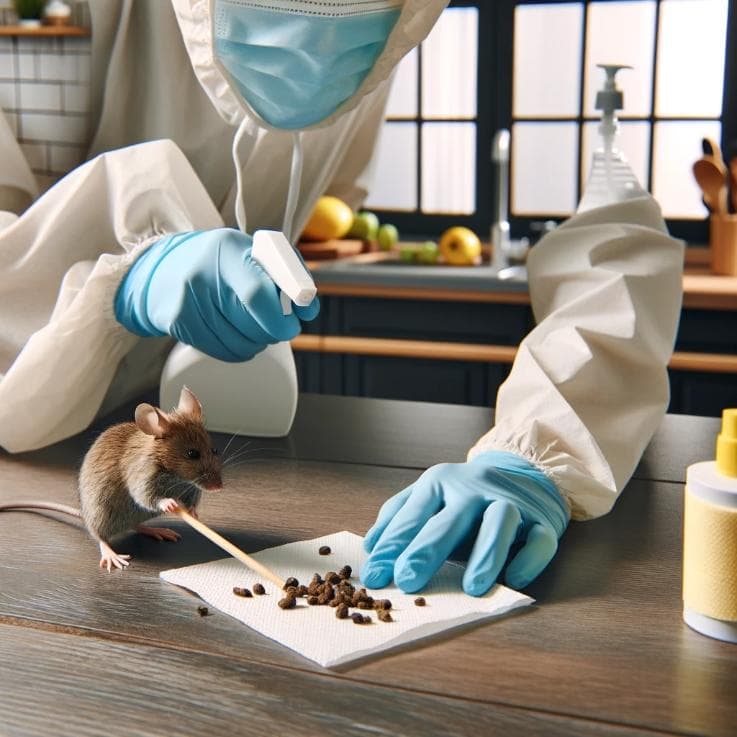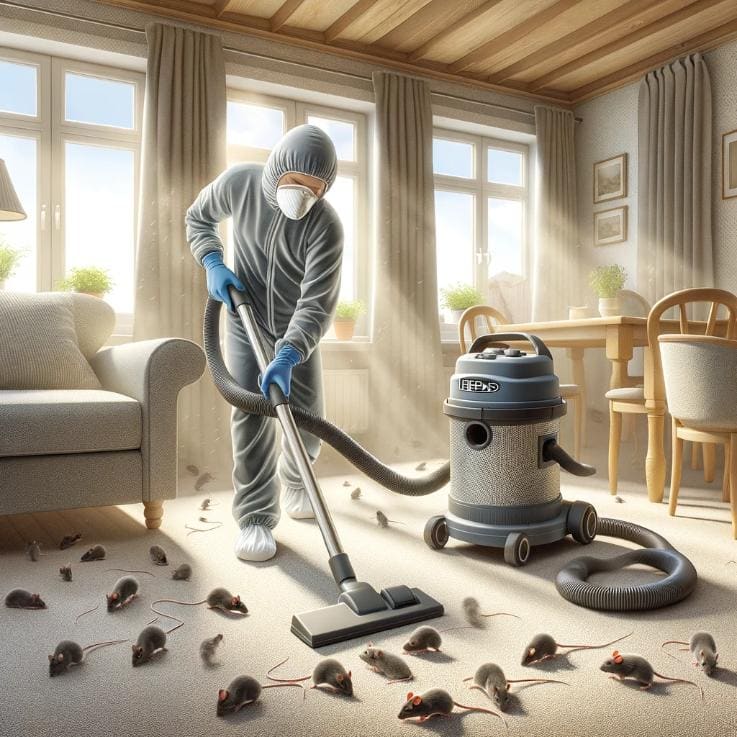Mouse droppings don’t just create a mess; they pose serious health risks. From dangerous pathogens to viruses like Hantavirus, these tiny droppings can endanger your well-being if not handled properly.
In this guide, we’ll walk you through the essential steps for safe mouse droppings removal. From identifying infestation signs to preparing for cleaning and using the right disinfectants, we’ve got you covered. We’ll also discuss natural and chemical alternatives for disinfection and provide practical solutions to common cleanup challenges.
By following these guidelines, you can ensure a safe and healthy environment while protecting yourself and your loved ones from potential health hazards. Let’s dive in and make your space cleaner and safer!
Key Takeaways
Stay safe and healthy when dealing with mouse droppings:
- Understand the health risks
- Use proper disinfection and sanitation
- Dispose of droppings responsibly
- Equip yourself with safety gear
- Monitor for infestation signs
- Consider natural and chemical disinfectants
- Address common cleanup challenges
- Stay vigilant to prevent future infestations
- Seek professional help for large infestations
Understanding the Importance of Safe Mouse Droppings Removal

1.1. Overview of the Health Risks Associated with Mouse Droppings
Mouse droppings in a home or business premises are not just inconvenient; they pose significant health risks. These risks stem from the pathogens and viruses in rodent urine and feces, including the potentially fatal Hantavirus. It’s crucial to understand that improperly handled droppings can spread these pathogens, endangering the health of occupants.
1.2. The Significance of Proper Disinfection and Sanitation
To mitigate these health risks, proper disinfection and sanitation are imperative. Using a disinfectant for droppings ensures the neutralization of harmful pathogens. When cleaning up after a mouse infestation, it’s vital to use a household disinfectant or a commercial disinfectant application. These substances are formulated to kill bacteria and viruses that may be present in mouse droppings, urine, and nesting materials.
1.3. Legal and Environmental Considerations in Droppings Disposal
The disposal of mouse droppings must be carried out by legal and environmental guidelines to prevent contamination. This involves safely bagging the droppings using a bleach-dampened paper towel and disposing of them in a sealed plastic bag. Rodent droppings disposal must be done thoughtfully to avoid any environmental hazards.
A comprehensive mouse droppings removal plan is essential for maintaining a safe and healthy environment. This involves using protective gloves to avoid direct contact with contaminants, employing a HEPA vacuum for droppings to prevent the spread of airborne particles, and ensuring all contaminated surfaces soak in disinfectants.
Understanding the dangers of mouse poop and taking proactive steps for rodent feces hazard mitigation, including hantavirus prevention steps, is critical. Proper droppings cleaning and disinfecting mouse nests are not just about cleanliness; they are about safeguarding the health and well-being of all occupants in the affected area.
Identifying Mouse Droppings and Infestation Signs

2.1. Recognizing the Appearance of Mouse Droppings
Identifying mouse droppings is a crucial indicator of a rodent presence in your environment. Typically, these droppings are small with a distinctive spindle shape, measuring around 3 to 6 mm long. They tend to be granular in texture and dark brown, appearing in clusters along mouse travel routes, near food sources, and hidden corners.
2.2. Locating Common Infestation Areas
To manage a mouse infestation effectively, it’s essential to pinpoint their most frequented areas. Key locations to inspect include under sinks, inside cupboards, along baseboards, and in secluded areas like attics or basements. Evidence of nesting, such as gathered fabric scraps, shredded paper, or insulation, often accompanies droppings, signaling active mouse habitats.
2.3. Distinguishing Mouse Droppings from Other Rodent and Insect Signs
Differentiating mouse droppings from those of other rodents or insects is critical for targeted pest control. Mouse droppings are notably smaller and less blunt than rat droppings and exhibit a more pointed shape, unlike the rounder droppings of insects such as cockroaches. Accurate identification is key to implementing the correct remediation and prevention strategies.
In sum, a thorough understanding of how to identify mouse droppings and their common habitat areas is essential for initiating an effective response to mouse infestations. This chapter provides a foundational knowledge base for distinguishing these signs from other pests, leading to more effective control measures in subsequent management stages.
Preparation for Cleaning Mouse Droppings
3.1 Essential Safety Gear and Materials Needed
As you embark on the task of cleaning mouse droppings, it is crucial to prioritize your safety. This chapter will discuss the essential safety gear and materials needed to ensure a thorough and safe cleaning process.
First and foremost, you should equip yourself with personal protective equipment (PPE). This includes gloves, goggles, and a face mask. Gloves protect your hands from direct contact with the droppings, while goggles shield your eyes from any potential airborne particles. The face mask is essential to prevent inhaling any harmful dust or bacteria in the droppings.
In addition to PPE, you will need a few key materials to clean the infested area effectively. These include disposable paper towels, plastic bags for waste disposal, a broom, a dustpan, and a vacuum cleaner with a HEPA filter.
The disposable paper towels are ideal for wiping up the droppings, while the plastic bags will ensure proper containment and disposal of the waste. The broom and dustpan will help gather larger droppings, and the vacuum cleaner with a HEPA filter will aid in thoroughly cleaning and removing smaller particles.
3.2 Ventilating and Securing the Infested Area
Before you commence the cleaning process, it is essential to ventilate and secure the infested area properly. This step will help minimize the spread of any potential airborne contaminants and ensure your safety.
To begin with, open all windows and doors in the affected area to promote proper airflow. This will help dissipate any odors and improve ventilation, reducing the concentration of allergens or bacteria present.
Next, ensure the area is adequately secured to prevent mice from re-entering while you clean. Seal cracks or openings that may serve as access points for mice using caulk or steel wool. By doing so, you create a barrier that will prevent further infestation.
3.3 Understanding and Choosing the Right Cleaning Agents
Cleaning agents are vital in effectively removing mouse droppings and sanitizing the area. It is essential to understand the different types of cleaning agents available and choose the right one for your specific needs.
Various cleaning agents, including disinfectants, bleach solutions, or enzymatic cleaners, can be used. Disinfectants are effective in killing bacteria and viruses present in the droppings. Bleach solutions can be used for sanitizing surfaces, but they should be used cautiously as they may discolor certain materials. Enzymatic cleaners are specifically designed to break down organic matter, making them an excellent choice for removing stubborn stains and eliminating odors.
When selecting a cleaning agent, consider factors such as the surface you are cleaning, the level of contamination, and any personal preferences or sensitivities to certain chemicals. Always follow the instructions on the product label and take necessary precautions, such as wearing gloves and ensuring proper ventilation.
By understanding the essential safety gear and materials needed, ventilating and securing the infested area, and choosing the right cleaning agents, you are well-prepared to clean mouse droppings. Remember to prioritize your safety throughout the process and maintain a thorough approach for effective results.
Step-by-Step Guide to Cleaning Mouse Droppings
4.1. Initial Cleaning: Removing Droppings and Contaminated Materials
The first step in addressing a mouse infestation involves thoroughly removing droppings and contaminated materials. Begin by donning protective gloves to minimize direct contact with hazardous materials. Utilize a HEPA vacuum to carefully remove droppings, especially from hard-to-reach areas, reducing the risk of airborne transmission.
For surfaces where vacuuming is impractical, a bleach-dampened paper towel can wipe up droppings. Ensure all materials, including droppings and nesting materials, are securely bagged in plastic for safe disposal.
4.2. Disinfecting and Sanitizing the Area
Once the initial cleanup is complete, the next critical step is disinfection. Apply a commercial disinfectant or a homemade bleach solution to all contaminated surfaces. Allow the disinfectant to soak on the surfaces for an adequate period as per the manufacturer’s instructions to ensure effective sanitation. Pay particular attention to areas where rodent urine and droppings were prevalent. Using a spray bottle can effectively apply the disinfectant, especially in tight spaces.
4.3. Preventive Measures to Avoid Airborne Transmission
During the cleaning process, minimizing the risk of airborne transmission of viruses like hantavirus is vital. Ensure the area is well-ventilated, opening windows and using fans if necessary. After applying disinfectants, avoid sweeping or vacuuming, which can aerosolize hazardous particles. Instead, continue to use wet cleaning methods to reduce this risk. Once cleaning is completed, carefully remove and dispose of gloves and wash hands thoroughly to prevent any potential spread of contamination.
Implementing a systematic approach to cleaning mouse droppings, prioritizing safety, and utilizing effective disinfecting methods is crucial in managing the risks associated with rodent infestations. This chapter outlines essential steps, ensuring a safe and thorough cleanup.
Disposal and Post-Cleaning Procedures

5.1. Safe Disposal of Contaminated Materials
After effectively cleaning mouse droppings and contaminated areas, it’s crucial to focus on safely disposing of these materials. Encase all collected droppings, nesting materials, and used cleaning wipes in a sturdy plastic bag. This practice is vital in preventing the spread of pathogens that may be present in the waste. Seal the bag tightly before disposing of it in an outdoor trash receptacle. In areas where specific regulations govern the disposal of such waste, ensure compliance to avoid legal and environmental repercussions.
5.2. Cleaning and Sanitizing Personal Protective Equipment
The importance of sanitizing personal protective equipment (PPE) cannot be overstated. After the cleanup, gloves, masks, and other protective gear are removed. Wash reusable items, like gloves, with a disinfectant solution or a bleach-dampened towel. For items that are not washable or reusable, dispose of them safely, using the same protocol as for contaminated materials. This step is crucial to prevent cross-contamination and maintain PPE’s effectiveness for future use.
5.3. Monitoring for Recurrent Infestations
Post-cleanup, continuous monitoring for signs of recurrent mouse infestations is essential. Regular checks in previously infested areas and implementing preventive measures can significantly reduce the risk of future infestations. Consider scheduling routine inspections and cleaning to ensure your space remains free from rodent activity. Implementing these vigilance steps is a proactive approach to maintaining a safe and healthy environment.
Ensuring the safe disposal of contaminated materials, proper sanitization of personal protective gear, and vigilant post-cleanup monitoring are critical components of a comprehensive mouse infestation cleanup strategy. This chapter emphasizes the importance of these steps in mitigating health risks and maintaining long-term safety and cleanliness.
Natural and Chemical Alternatives for Droppings Disinfection

6.1. Pros and Cons of Using Chemical Disinfectants
In mouse infestation cleanup, chemical disinfectants play a pivotal role. Their efficacy in killing pathogens, including those associated with hantavirus, is well-established. However, it’s essential to consider their potential downsides. Overexposure can lead to respiratory issues and skin irritation. It’s imperative to use these disinfectants in well-ventilated areas and adhere to the manufacturer’s instructions. The use of protective gloves and ensuring proper dilution ratios are non-negotiable aspects of safe usage.
6.2. Natural Alternatives and Their Effectiveness
Natural alternatives offer a viable option for those seeking a more environmentally friendly approach. Substances like vinegar and certain essential oils have been noted for their disinfecting properties. While they may be less harsh and more eco-friendly, it’s crucial to understand their limitations. Their effectiveness against certain viruses and bacteria, including those found in rodent droppings, might not match that of commercial chemical disinfectants. Consequently, they should be used with other cleaning practices for optimal results.
6.3. Making an Informed Choice for Your Situation
Deciding between natural and chemical disinfectants hinges on individual circumstances and preferences. For extensive infestations or where the risk of hantavirus is high, commercial disinfectants with a proven track record of neutralizing a wide range of pathogens are advisable. In contrast, natural alternatives can be a safe and practical choice for minor cleanup tasks or regular maintenance. Regardless of the selection, ensuring thorough cleaning of contaminated surfaces, proper droppings disposal, and adherence to safety protocols is paramount.
This chapter aims to provide a balanced view of natural and chemical alternatives for disinfecting areas affected by mouse droppings. Understanding the pros and cons of each option empowers individuals to make informed decisions based on the severity of the infestation and personal health considerations.
Addressing Common Challenges and Solutions
7.1. Cleaning Droppings in Hard-to-Reach Areas
Addressing the challenge of cleaning mouse droppings in hard-to-reach areas requires a strategic approach. Employing a HEPA vacuum is crucial in these scenarios. This specialized equipment efficiently removes droppings, nesting materials, and contaminated dust without dispersing harmful particles into the air. Long-handled brushes or damp cloths can be used for areas inaccessible to vacuums, ensuring that a bleach solution or a commercial disinfectant is applied to sanitize these surfaces thoroughly.
7.2. Dealing with Large Infestations and Severe Contamination
In extensive mouse infestation cleanup cases, the magnitude of contamination can be overwhelming. Here, the primary step is to don protective gloves and use a disinfectant for droppings to mitigate the risk of hantavirus and other rodent feces hazards. After the initial cleanup with a bleach-dampened paper towel, a more profound disinfecting process is required. Soaking contaminated surfaces in a household disinfectant or a bleach solution ensures the neutralization of pathogens. For large-scale infestations, seeking professional services for comprehensive cleaning and disinfection may be prudent.
7.3. Professional Services vs. DIY: Making the Right Choice
The decision between a do-it-yourself approach and professional services hinges on the scale of infestation and individual capability. While DIY methods can be effective for small-scale problems, significant infestations often require the expertise and equipment that professional services offer. These experts can effectively address mouse poop dangers, safely dispose of rodent droppings, and apply commercial disinfectants more efficiently. Additionally, professionals can provide insight into preventive measures and long-term solutions to avoid future infestations.
Chapter 7 focuses on practical solutions to common challenges during mouse-dropping cleanup. It emphasizes the importance of using the right tools and techniques for different scenarios, weighing the pros and cons of DIY versus professional intervention. This guidance ensures readers can effectively tackle mouse droppings-related problems while prioritizing safety and efficacy.
Conclusion: Ensuring Long-Term Safety and Prevention
9.1. Recap of Key Points for Effective and Safe Droppings Removal
In conclusion, effective and safe removal of mouse droppings is a critical task that requires careful attention to detail. We have explored the health risks associated with mouse droppings, such as hantavirus, and emphasized the importance of using protective gloves and appropriate disinfectants for droppings. The use of HEPA vacuum droppings, along with a bleach solution disinfection, ensures the neutralization of hazardous pathogens.
9.2. Importance of Ongoing Vigilance and Prevention Strategies
Ongoing vigilance is essential in preventing future mouse infestations. Regularly inspecting common areas for droppings and nests, employing preventive measures like urine and droppings spray, and disposing of waste in plastic bags are critical steps. Additionally, understanding the hazards of rodent feces and the importance of disinfecting mouse nests can’t be overstated. Always ensure contaminated surfaces soak sufficiently in household disinfectants to eliminate risks.
9.3. Resources for Further Information and Assistance
For those seeking further information or assistance, numerous resources are available. These include professional services for mouse infestation cleanup and guidance on proper droppings cleaning. It’s advisable to consult experts, especially when dealing with large infestations or severe contamination, as they can provide specialized commercial disinfectant applications and advice on safe droppings removal and rodent droppings disposal.
Remember, the key to effective removal of mouse droppings lies in the immediate cleanup and maintaining a vigilant and proactive approach to prevention. By following these guidelines and utilizing the resources available, you can ensure your environment’s long-term safety and sanitation.
References
How to Clean and Disinfest After Rat or Mouse Infestation | Orkin
How to Clean Up After a Mouse Infestation

Welcome to micegoneguide.com, your go-to resource for eliminating rats and mice. Say goodbye to rodent infestations with our expert tips and strategies. Visit us now and reclaim your space!










